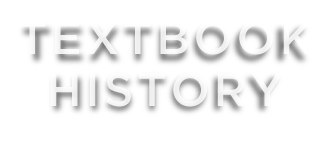July 31, 2019. (Originally published in longer form as “Biology Textbooks in the 1940s: If Not Eugenics, What?” – January 22, 2019).
The 1940s were a pupil-poor and scientifically unsettled time for U.S. secondary school biology textbook authors and publishers. The economic depression of the preceding decade led directly to a reduction in both birth rates and absolute births. Between 1940 and 1947, the number of students eligible for high school biology decreased by more than 13%. [1] Making matters worse, World War II interrupted the free flow of scientific information right as new ideas about evolution, eugenics and race were coming into focus, forcing (or encouraging) authors to rely on old information or kind of wander around.
This created an odd market where idiosyncratic works by authors on soapboxes competed for a share of a shrinking audience with barely revised reprints of out-of-date texts and encyclopedic works that purportedly instructed students how to “adjust” to life. Only a few of these weird creatures would survive the decade.
Of the 16 new or revised high school biology textbooks published during the 1940s, only two managed to successfully navigate the harsh environment. The first, the perennially popular (and pandering) Modern Biology by Truman J. Moon, Paul B. Mann and James H. Otto, first published in 1921, gained a strong foothold in the market with revised editions in 1926, 1933 and 1938. It’s unlikely rival, Exploring Biology, started life as the kitchen table project of a small-town high school teacher named Ella Thea Smith and her illustrator husband, Marion Cox. By the end of the 1950s, these two textbooks would command 75% of the market. [2]
All the other textbooks published in the 1940s, save one, died before the Cold War even heated up. Aside from Moon and Smith, only Adventures with Animals and Plants – originally Adventures with Living Things (1938) and later Biology (1957) – by Elsbeth Kroeber and Walter Wolff, managed to limp into the 1960s (see related article). Strangely, the harsh and arid marketplace of the 1940s somehow encouraged textbook experimentation, while the verdant landscape of the 1950s, where the number of students enrolled in high school biology increased by about 45%, led to a rapid constriction and die-off. Why did Moon and Smith survive while the others went extinct?
As with so many things in the human sphere, a lot of it had to do with sex.
A Quick Review: The Birth of Biology
High school biology as a coherent course of study came into being in the early twentieth century when the scheduling demands of an industrialized public education system forced administrators to combine the traditionally separate one-semester subjects of botany, zoology and human physiology into one single year-long course. [3]
The subject quickly evolved.
By 1914, a prescriptive curriculum emerged, one that not only described the parts, systems and environments of living things, but also the proper habits, behaviors and life roles for students studying the subject. By 1920, ninth and tenth grade boys and girls were being told by their textbooks who they should marry, the types of jobs they should settle for, and why unmanaged immigration and welfare were imminent threats to the social order.
During this growth spurt, the decade between George W. Hunters Civic Biology (1914) and James Peabody and Arthur Hunt’s Biology and Human Welfare (1924), textbook authors positioned themselves as social managers and the science of biology as the antidote to superstition, myth and emotional decision making. They advanced a eugenics-based narrative that substituted state control for self control, and supported it with mash of quasi-Lamarckian and orthogenetic ideas that passed for evolutionary theory at the time.
These textbooks, replete with horror stories about degenerate offspring, served as a brutal form of sex education, designed to keep adolescents from coupling too soon or with the “wrong” people.
But early textbook authors got a little ahead of themselves and let their enthusiasm for biologized social control go to their heads, and events conspired to bring them and their curriculum back to earth. The anti-evolution movement of the early 1920s, which culminated in the Scopes Trial of 1925, through cast as battle between religion and science, was in part a populist effort to blunt biology’s progressionist thrust. But it was the cumulative assault of the Great Depression, the rise of Fascism in Europe and nativism in the U.S., the lessening fear of venereal disease and growing evidence that eugenics simply couldn’t work that combined to pop biology’s pretenses.
By 1940, biology’s core narrative had been dramatically weakened.
Yet the demand for a curriculum that could control adolescent sexuality, had, if anything, only increased since the 1920s. Worries about what their sons and daughters were getting up to in the backseats of their new cars or in the sketchy motor courts popping up at the edge of town suggested a fertile opportunity, even in a down market.
The Textbooks
Elliot Downing (b. 1868) was a naturalist who promoted engagement with the environment as a path to enlightenment. He was the author of Elementary Eugenics (1928), originally published as The Third and Fourth Generation: An Introduction to Heredity (1918), a reference work widely cited in the heredity section of biology textbooks in the 20s and 30s. [7]
Having come of intellectual age in the years between the rediscovery of Mendel’s laws of genetics and the reconceptualization of evolutionary biology we now call the modern synthesis, Downing, like most of his peers, held mixed and tangled views regarding the direct influence of the environment on hereditable characteristics. For example, in The Third and Fourth Generation, Downing suggested a child raised in the home of an alcoholic, even one with no prior family history of alcoholism, because of the influence of the environment, might gain a genetic predisposition to alcoholism and pass that predisposition on to offspring. He wrote, “… while acquired modifications are not transmissible hereditarily, those influences which affect the body may also directly affect the germ plasm and produce heritable results” (118). And Downing warned, “The effects of such sins as alcoholism and sexual impurity are transmitted apparently to the children to the third and fourth generation” (120).
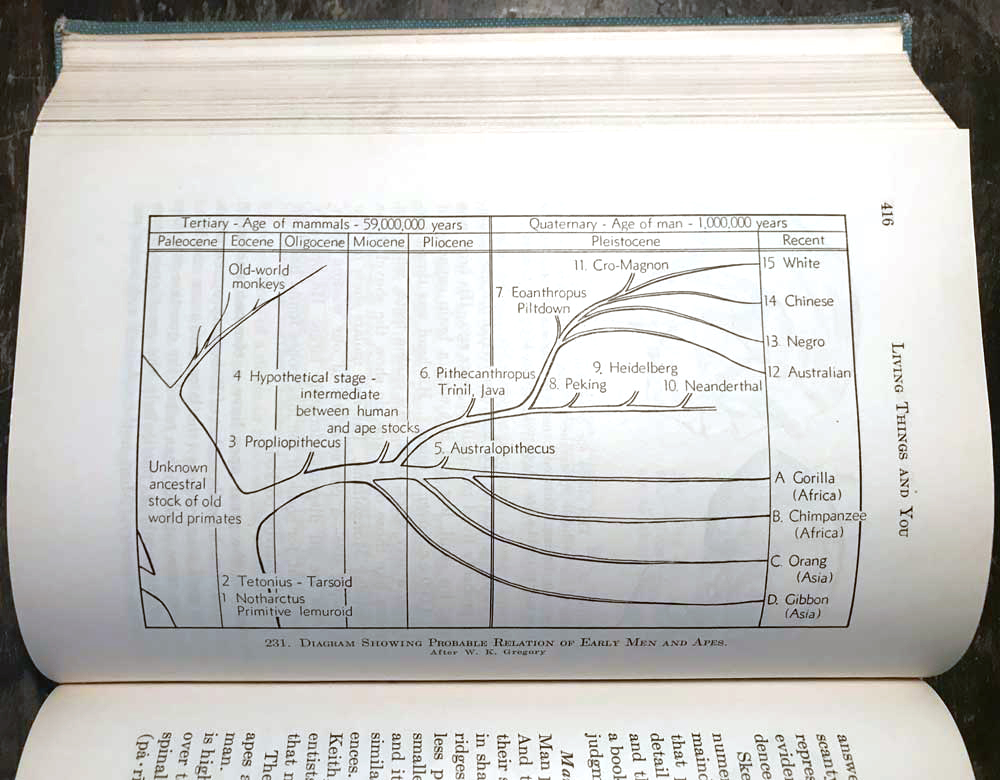
The images and charts used in 1940s-era biology textbooks often communicated clear messages regarding racial hierarchies, as demonstrated by the top-to-bottom ordering in the right column of this graphic. More subtle was the eugenic message. Note Cro-Magnon, positioned as a branch of the white race as “advanced” as modern whites, perhaps even more robust. But authors warned, the weight of immigration and racial mixing were threatening to pull the white branch down. (Downing and McAntee, 1940, p. 416.). See related: related article.
In 1940, Downing teamed with Veva McAtee to author the first new textbook of the decade, Living Things and You. Though the authors took pains to highlight the ridiculousness of Lamarckism, they couldn’t bring themselves to the conclusion that the environment or individual behavior had no impact on the genome. Though the book does not index eugenics, the authors saw no reason to dissuade students from its future application, writing, “To prevent the continued breeding of inferior human stock and to stimulate the reproduction of the superior type would seem unquestionably desirable in the light of man’s experience in the improvement of domestic plants and animals” (505).
Downing and McAtee’s textbook represented an emerging middle position between eliminating or significantly downplaying eugenics and its restoration and full-throated defense, a position that had been promoted by a group of socially liberal scientists since the mid-1930s and given the label “reform eugenics” by Daniel Kevles. [8]
The goal was to wash eugenics of its dirty association with racism, nativism and fascism.
Other 1940’s authors who actively adopted reform eugenics (or just happened to fall into this middle camp by watering down their eugenic pronouncements) include Arthur O. Baker and Lewis H. Miles in Dynamic Biology Today (1943), Francis D. Curtis, Otis W; Sherman, Nina Henry in Everyday Biology (1943), W. M. Smallwood, Ida L. Reveley, Guy A Bailey and Ruth Dodge in Elements of Biology (1948), and Charlotte L. Grant, H. Keith Cady and Nathan A. Neal in their first and only text, American High School Biology (1948). Of these, the last, Grant’s American High School Biology, provides the best example of the impossible contradictions reform eugenicists encountered when attempting to promote conscious and positive genetic selection squared with both an awareness of the independent impact of environment on health and human potential and a politically progressive view of race.
American High School Biology’s chapter titled “Heredity in Human Beings” included in its references the two most commonly cited texts of the reform eugenics movement, Amram Scheinfeld’s popular science book, You and Heredity (1939), [9]
and Ruth Benedict and Gene Weltfish’s pamphlet, “The Races of Mankind,” originally produced for the US Army in 1943.
In attempting to reconcile these two documents, Grant and her co-authors swung wildly from genetic determinism to environmentalism. They took great pains to remind students again and again that they must always remember that environmental factors often determine the relative success of a person or group. At the same time, they had no issue stating, “Even though many factors in the environment may affect the mental achievement of a person, it is well known that some people inherit greater ability than others” (643). Then just four pages later contradicted themselves by writing, “it is thought today that much insanity is more related to the environment than to hereditary traits” (648). Then on the following page confidently stated, “By using intelligence, as well as emotional feeling, in selecting one’s future husband or wife, it may often be possible to contribute to the improvement of the human race” (649). Then followed with, “You are likely to live a happier life and to have happier and healthier children if you make use of what you know about heredity in selecting the person you marry” (649). And finely closed with a six-page defense of the equality of the races, implying miscegenation laws then on the books were wrong.
Reform eugenicists suggested it was one’s duty to the future of the species for individuals, including high school sophomores, to judge potential mates not just on “emotional feeling,” but also on expressed and identifiable traits, whether due to genetics or the environment. Simultaneously, they demanded that students not judge groups based on characteristics associated with racial and cultural differences. Simply put, they were asking students to judge and not judge at the same time. Strictly from a marketing perspective, reform eugenics offered the worst of both worlds to an audience seeking to reinforce racial and class boundaries.
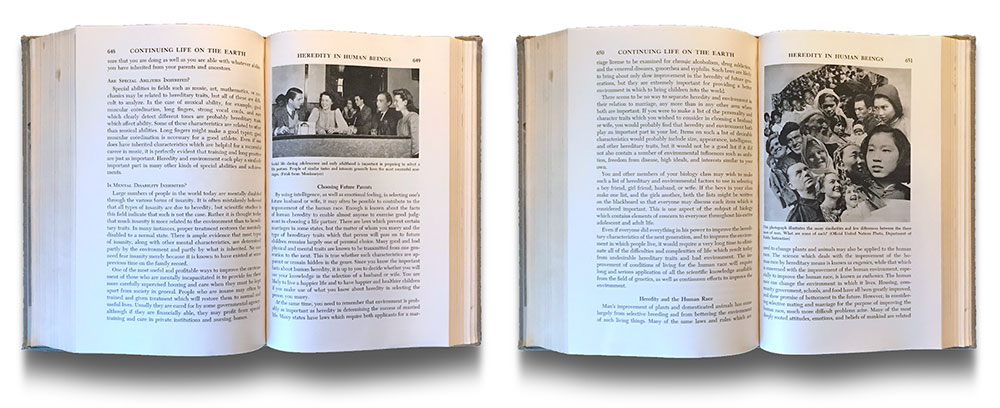
In closing their chapter on “Heredity and Human Beings,” the authors of American High School Biology (1948) asked students to take into consideration the lessons taught on heredity and eugenics when selecting a life partner, and not choose solely based on “emotional feeling.” Then on the very next spread, using a photo montage published by the United Nations Department of Public Instruction, reminded students not to judge individuals based on obvious physical traits, at least as they related to race.
American High School Biology saw just one edition. In 1955, Ginn and Company updated Everyday Biology as a reform eugenics text, retitling it Biology and Daily Life. It went out of print after its 1958 edition. And in 1959, Rand McNally & Company attempted to revive Dynamic Biology Today under the title New Dynamic Biology, also by updating the text against a reform eugenics framework. It too went out of print.
The Life Adjustment Alternative
Perhaps the most significant alternative to reform eugenics texts to emerge in the 1940s was the so-called “life adjustment” curriculum.
In 1945, at a conference of the Vocational Education Division of the U.S. Office of Education, Charles A. Prosser proposed greatly expanding vocational education so it would offer “life adjustment training” to all students who were not college bound. The standard high school curriculum, it was said, served 20% of the country’s students who saw a future in good grades and would knuckle down and not be distracted. Another 20% of students could find satisfaction in vocational programs that led to satisfying jobs right out of school. But what of the middle 60%? What would keep them engaged and out of trouble?
Historians have long loved to hate the life adjustment curriculum. Many – famously Arthur Bestor in the 1950s and Richard Hofstadter in the 1960s – attacked the movement as anti-intellectual. However, as William G. Wraga argues, many if not most critics rely on a cartoon view of life adjustment to support whatever contemporary critiques they are attempting to make. Life adjustment, according to Wraga, can be seen not as anti-intellectual, but as an honest effort to counter a conservative, conformist ideology present in public education since its inception. Wraga argues for a reexamination of primary sources, a quick review of which will uncover the fact that life adjustment was neither very radical, or frankly all that influential. [10]
When we look at the primary sources, specifically the textbooks, we see life adjustment, as an idea, was firmly in place a half decade before it was labeled by Prosser. In his 1941 textbook, Science of Living Things, author Clinton G. Weymouth states in his preface that the purpose of biology is “… to acquaint students with biological principles which would be of great value in solving everyday problems (iii).” Francis D. Curtis retitled his 1934 textbook, Biology for Today, Everyday Biology when it was reissued with virtually no other changes in 1943. And in 1946, two new textbooks attempted to pick up on the life adjustment trend, Ernest E. Bayles and Will R. Burnett’s Biology for Better Living and B. B. Vance and D. F. Miller’s Biology and You.
What is notable is that all four of the life adjustment-based biology textbooks published in the 1940s were either very lightly eugenic relative to the age, or in the case of Bayles’ Biology for Better Living, actively anti-eugenic. But what is also notable is that this non-eugenic curriculum was already on the wane by the time Prosser named it.
Going All-In on Eugenics
While Elliot Downing and Veva McAtee were pioneering a reform eugenics compromise with Living Things and You, and the life adjustment authors were attempting to develop a marketable alternate to the proscriptive textbooks of their contemporaries, sanitation enthusiast (and germ freak) John W. Ritchie (b. 1871) came out of retirement with a 1000-page textbook titled Biology and Human Affairs (1941). In it, Ritchie went all-in on the full eugenic package – racial difference, class ordering and the “elimination of defectives.” [11]
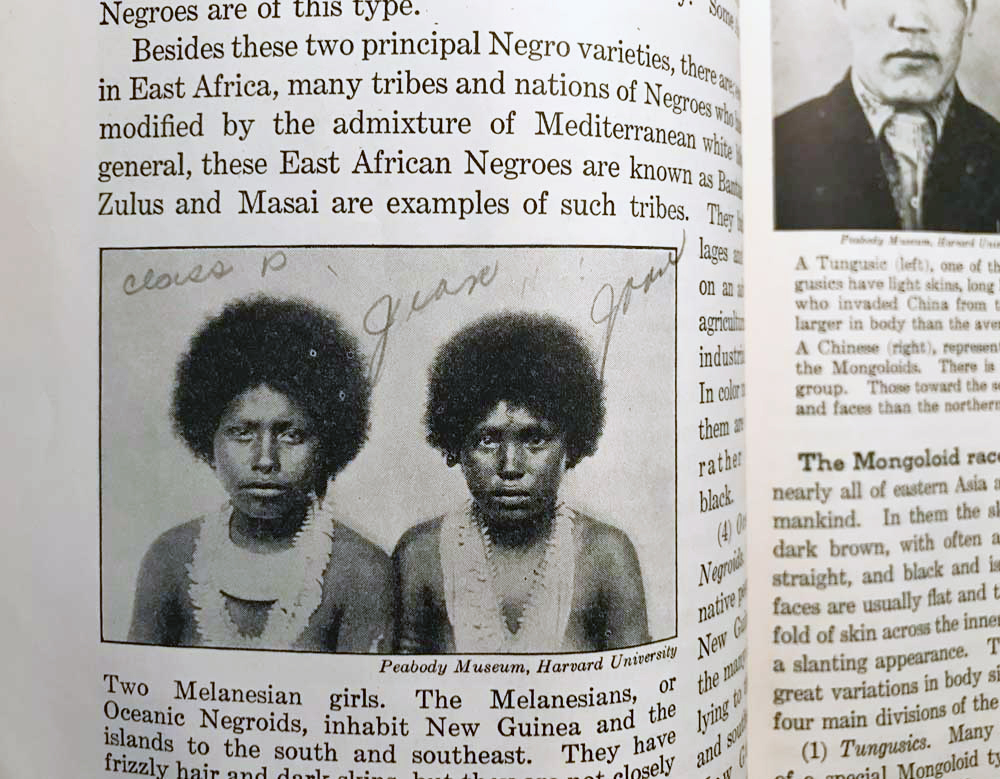
Images and illustrations depicting evolutionary development and racial divisions were often “recontextualized” by students. Through their literal sophomoric humor, students demonstrated they fully understood the hierarchy of dominance their textbooks were promoting – teachers and school authorities at the top, they and their (white) classmates in the middle, and those they’d been given permission to deride below. (Ritchie, 1941, p. 64.)
Ritchie promoted eugenics using the language of its earliest and harshest enthusiasts.
In animals the feeble and defective are eliminated by natural selection or by the selection of the breeder. In civilized society we nurse and carry the undesirables along until we have an enormous population of feeble-minded, criminal, shiftless, and insane. The eugenicist would eliminate these from the human breeding stock (699).
Ritchie opened his text with a 29-page section on “principal races of mankind” that ordered each supposed finely-divided subdivision of our species on a progressive scale, and then used it to support his eugenic arguments throughout. Though Ritchie died in 1943, a “new edition” of Biology and Human Affairs was published in 1948. Though shortened a bit, Ritchie’s “old eugenics” remained firmly in place.
Though clearly the work of a man who had been out of the mainstream and out of the market for decades, in its stridency, Biology and Human Affairs in fact anticipated the direction college biology textbook authors would take later in the decade (see related article), and that the most popular high school textbook would adopt as well. [12]
As the reform eugenics and life adjustment textbooks faded one after another, Ritchie’s brand of hardline eugenics is what attracted a sustaining audience.
(Not So) Modern Biology
Truman J. Moon and Paul B. Mann’s Biology (1941 and 1946) was in serious need of revision at the end of World War II. First published in 1921, the textbook, originally titled Biology for Beginners, had been revised in 1926, 1933, 1938, 1941 and 1946. Though it remained popular, it was fast falling behind the times. [13]
Two new competitors had emerged, both written fresh in 1938. Though still representative of only a small share of the market, Elsbeth Kroeber and Walter H. Wolff’s Adventures with Living Things and Ella Thea Smith’s Exploring Biology signaled a shift. Both broke from the pedantic style, overt racism and obvious judgmental lessons of their predecessors.
In 1947, Henry Holt and Company hired high school teacher James H. Otto to revise Moon and Mann’s Biology (both original authors had died) to meet the emerging demand for a more modern curriculum without threatening its legacy relationships.
Otto revised the original’s chapter organization so that it more closely matched its competitors, but only lightly edited the text and barely updated its science. Otto retained the euphemism Moon had adopted for evolution after the Scopes trial – racial development – and ignoring the trend, doubled-down on eugenics.
Retitled Modern Biology, Otto’s textbook now featured linked sections on reproduction, heredity, directed plant and animal breeding, and “genetics applied to human inheritance” that worked to project a “scientific” rationalization for traditional hierarchies and racial borders. His remarkably reactionary twelve-page climax presented eugenics without dilution, positively citing, for example, Charles B. Davenport and the eugenics work he led at Cold Spring Harbor, despite the fact that the Eugenics Record Office had been defunded and closed in 1939, and Davenport had died in 1944, discredited.
So Why Was Smith Successful?
Two textbooks first published in 1938 helped define and establish a fourth possible path to market success for biology textbooks, Elsbeth Kroeber and Walter H. Wolff’s Adventures with Living Things and Ella Thea Smith’s Exploring Biology. [14]
While Kroeber and Wolff’s textbook languished in the marketplace, Smith’s Exploring Biology over its next four editions proved a success. By 1959 it would command 25% of the market.
From her first published edition, Smith had actively countered the claims of eugenicists, finally deleting all references to the topic in 1959. [15]
Additionally, as early as 1943, influenced by Benedict and Weltfish’s “The Races of Mankind,” Smith featured significant sections countering common racial stereotypes and misconceptions, while making sure to decouple her discussions of race from evolution and the inevitable associated implication that human races could be ranked against a progressive scale (see related article). What her text lacked in terms of proscriptive stories designed to keep students from straying sexually outside the borders of their class and race, it made up for in terms of general quality and promotion of student empowerment. The text’s “unit-problem” structure and ample hands-on lessons would fit comfortably into a modern STEM curriculum.
The success of Smith’s textbook does suggest there was a market, emerging in the 1940s and developing through the 1950s, for a biology textbook that did not actively work to police the sexual behavior and social expectations of students. Though one might argue that respecting the learning capabilities of high school sophomores and rewarding engagement helped students see a future past their high school years, and that this provided a form of behavioral control, that’s probably stretching a point.
Tragically, though Smith was able to compete successfully against all other private publishers in the dramatically evolving marketplace of the 1940s and 50s, her accomplishments were not generally recognized by her professional peers. When, starting in 1959, the federally funded Biological Sciences Curriculum Study (BSCS) began developing what would become three big new biology textbooks, Smith’s work was dismissed. [16]
Though the BSCS authors erased all references to eugenics in their new texts, their desire to restore biology as a critical managerial force during the Cold War inevitably led them to position evolution as progressive and even controllable, which inevitably led right back to the contradictions faced by reform eugenicists. Sadly, because it offered a conservative alternative to these new textbooks, Modern Biology, with its barely reconstructed views on race and class, survived and thrived, while Smith’s Exploring Biology, though arguably more progressive than any textbook on the market, went out of print.
Footnotes
[1] Snyder, Thomas D. (ed). 120 Years of American Education: A Statistical Portrait. PDF. Washington DC: U.S. Department of Education, 1993. https://nces.ed.gov/pubs93/93442.pdf.
[2] For a comprehensive history of high school biology textbooks in the first six decades of the twentieth century, see: Ladouceur, Ronald. 2008. “Ella Thea Smith and the Lost History of American High School Biology Textbooks.” Journal of the History of Biology 41: 435-471.
[3] A remarkable record of the birth of the modern biology curriculum can be found in the journal School Science and Mathematics. Gruenberg, Linville, and Hunter all published lengthy articles in the journal between the key years 1908 and 1910.
[4] For an overview, see: Sappol, Michael. A Traffic of Dead Bodies. Princeton: Princeton University Press, 2002.
[5] See: Collins, Jodie, “Why was masturbation such a medical concern in the 19th century?”, Jode Bloggs (blog), March 19, 2015, https://jodebloggs.wordpress.com/2015/03/19/why-was-masturbation-such-a-medical-concern-in-the-19th-century/.
[6] See: Ladouceur, Ronald, “I Speak to You Through Electrical Language: Traveling Into the Nineteenth Century with the ‘Nervous Icon,’” Textbook History (online journal), June 6, 2012, https://textbookhistory.com/i-speak-to-you-through-electrical-language/.
[7] By 1941, Elliot Downing had been retired for seven years from the faculty of Northern State Normal School (now Northern Michigan University). Though he’d written several books intended for classroom and public use, including Our Living World (1924), Our Physical World (1925) and Science in the Service to Health (1930) and A Naturalist in the Great Lakes Region, Living Things and You (1940) was his first biology textbook.
[8] See: Kevles, Daniel J., 1986, In the Name of Eugenics: Genetics and the Uses of Human Heredity. Berkeley: University of California Press.
[9] See: Ladouceur, Ronald P. “Reform Eugenics and the Gender Bomb.” Textbook History (online journal), September 13, 2009, https://textbookhistory.com/reform-eugenics-and-the-gender-bomb/.
[10] See: Wraga, William G. “From Slogan to Anathema: Historical Representations of Life Adjustment Education.” American Journal of Education, Vol. 116, No. 2 (February 2010), 185-209. Also see: Rudolph, John L. Scientists in the Classroom: The Cold War Reconstruction of American Science Education. New York: Palgrave, 2002.
[11] Between 1909 and 1920, Ritchie was a star author for the World Book Company. His early textbook efforts attempted to fuse basic nineteenth century anatomy with prescriptive lessons in hygiene and behavior. This proved a curricular dead-end, and there is no record of Ritchie teaching beyond 1919 or publishing after 1920. The World Book Company filed for bankruptcy in 1933 but reentered the market in 1941 with Biology and Human Affairs.
[12] See: Ladouceur, Ronald P. “The Eugenic Zombie in a Graveyard of Textbooks.” Textbook History (online journal), August 7, 2011, https://textbookhistory.com/the-eugenic-zombie/.
[13] See: Ladouceur, Ronald P. “The Weight of the Moon or How a Single Textbook Skewed Our View of History.” Textbook History (online journal), November 29, 2009, https://textbookhistory.com/the-weight-of-the-moon-or-how-a-single-textbook-skewed-our-view-of-history/.
[14] See: Ladouceur, Ronald P. “Kroeber and Wolff’s Excellent Adventures.” Textbook History (online journal), November 5, 2009, https://textbookhistory.com/kroeber-and-wolffs-excellent-adventures/.
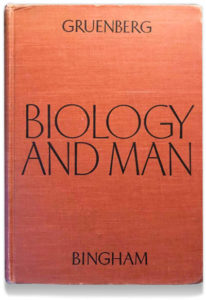 [15] The first (and perhaps only) textbook author to fully distance himself from eugenics after having previously promoted the topic was Benjamin C. Gruenberg, co-author of Biology and Man (1944). Gruenberg was the husband of the pioneering child care expert Sidonie Matzner Gruenberg, and both were acolytes of Felix Adler, founder of the Ethical Culture Society, and subscribers to his ideology of secular humanism. After teaching high school for 17 years, Gruenberg took a leave of absence in 1920 to inaugurate sex education programs on behalf of the U.S. Bureau of Education and write a series of manuals on his favored topics, sex education, evolution and pedagogy. He would go on to author How We Can Teach about Sex (1946), and with his wife, The Wonderful Story of You (1952). However, despite his background and active interest in sex education, Gruenberg’s 1944 textbook was far from groundbreaking in this regard. While Biology and Man’s sections on reproduction, heredity and evolution were comprehensive, clear, and free of any nasty eugenic tang, the text surprisingly steered clear of any discussion of human sexuality, positive or proscriptive. Worse, in its structure and methods, Biology and Man carried forward a preachy pedagogical style.
[15] The first (and perhaps only) textbook author to fully distance himself from eugenics after having previously promoted the topic was Benjamin C. Gruenberg, co-author of Biology and Man (1944). Gruenberg was the husband of the pioneering child care expert Sidonie Matzner Gruenberg, and both were acolytes of Felix Adler, founder of the Ethical Culture Society, and subscribers to his ideology of secular humanism. After teaching high school for 17 years, Gruenberg took a leave of absence in 1920 to inaugurate sex education programs on behalf of the U.S. Bureau of Education and write a series of manuals on his favored topics, sex education, evolution and pedagogy. He would go on to author How We Can Teach about Sex (1946), and with his wife, The Wonderful Story of You (1952). However, despite his background and active interest in sex education, Gruenberg’s 1944 textbook was far from groundbreaking in this regard. While Biology and Man’s sections on reproduction, heredity and evolution were comprehensive, clear, and free of any nasty eugenic tang, the text surprisingly steered clear of any discussion of human sexuality, positive or proscriptive. Worse, in its structure and methods, Biology and Man carried forward a preachy pedagogical style.
[16] For a history of the BSCS, see: Engleman, Laura, (ed.). The BSCS Story: A History of the Biological Sciences Curriculum Study. Colorado Springs: BSCS, 2001.
References
Baker, Arthur O., Lewis H. Mills. Dynamic Biology Today. New York: Rand McNally & Company, 1943.
Bayles, Ernest E. Biology for Better Living. New York: Silver Burdett Company, 1946 (1941).
BSCS. (“Blue” Version) Biological Science: Molecules to Man. Boston: Houghton Mifflin Company, 1963.
–. (“Green” Version) High School Biology. Chicago: Rand McNally & Company, 1963.
–. (“Yellow” Version) Biological Sciences: An Inquiry into Life. New York: Harcourt, Brace & World, 1963.
Curtis, Francis D., Otis W. Caldwell, Nina Henry Sherman. Everyday Biology. Boston: Ginn and Company, 1943.
Downing, Elliot R. Living Things and You. Chicago: Lyons and Carnahan, 1940.
Grant, Charlotte L. American High School Biology. New York: Harper & Brothers Publishers, 1948.
Gruenberg, Benjamin C., N. Eldred Bingham. Biology and Man. Boston: Ginn and Company, 1944.
Hunter, George W. 1907. Elements of Biology. New York: American Book Company.
–. Essentials of Biology. New York: American Book Company, 1911.
–. Civic Biology. New York: American Book Company, 1914.
–. New Essentials of Biology. New York: American Book Company, 1923.
–. New Civic Biology. New York: American Book Company, 1926.
Kroeber, Elsbeth, Walter H. Wolff. Adventures with Living Things. Boston: D. C. Heath and Company, 1938.
–. Adventures with Animals and Plants. Vancouver: The Copp Clark Publishing Co. Limited, 1950 (1948)
Moon, Truman J. 1921. Biology for Beginners, New York: Henry Holt and Company, 1921. Reproduced in facsimile, New York: Holt, Rinehart and Winston, 1981.
Moon, Truman J., Paul B. Mann. Biology for Beginners. New York: Henry Holt and Company, 1933.
–. Biology: A Revision of Biology for Beginners. New York: Henry Holt and Company, 1946.
Moon, Truman J., Paul B. Mann, James H. Otto. Modern Biology. New York: Henry Holt and Company, 1951.
–. Modern Biology. New York: Henry Holt and Company, 1956.
–. Modern Biology. New York: Holt, Rinehart and Winston, 1960.
Ritchie, John W. Biology and Human Affairs. Yonkers-On-Hudson: World Book Company, 1941.
–. Biology and Human Affairs (New Edition). Yonkers-On-Hudson: World Book Company, 1948.
Rudolph, John L. Scientists in the Classroom: The Cold War Reconstruction of American Science Education. New York: Palgrave, 2002.
Smallwood, William M., Ida L. Reveley, Guy A. Bailey, Ruth A. Dodge. Elements of Biology. Boston: Allyn and Bacon, 1948.
Smith, Ella Thea. Biology: The Science of Life (unpublished). Salem, Ohio: Salem Historical Association, 1932(?).
–. Exploring Biology. New York: Harcourt, Brace and Company, 1938.
–. Exploring Biology: New Edition. New York: Harcourt, Brace and Company, 1942.
–. Exploring Biology: Third Edition. New York: Harcourt Brace and Company, 1949.
–. Exploring Biology: Fourth Edition. New York: Harcourt, Brace and Company, 1954.
–. Exploring Biology: Fifth Edition. New York: Harcourt, Brace and World, 1959.
Vance, B. B., D. F. Miller. Biology for You. Chicago: J. B. Lippincott Company, 1946.
Weymouth, Clinton G. Science of Living Things. New York: Henry Holt and Company, 1941.
